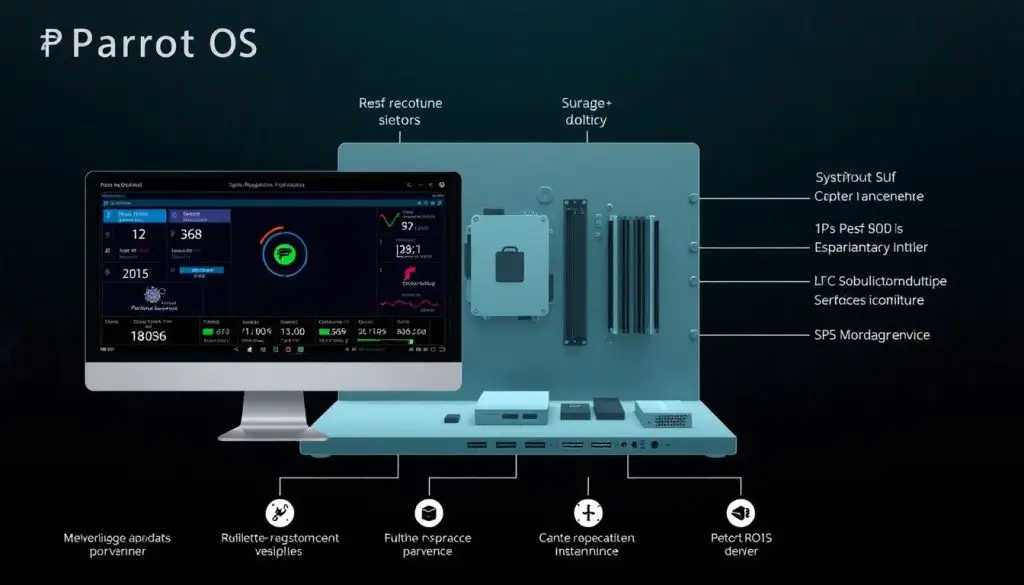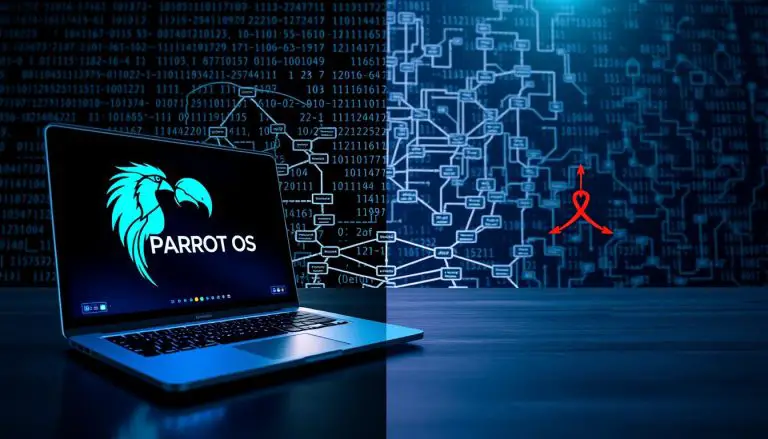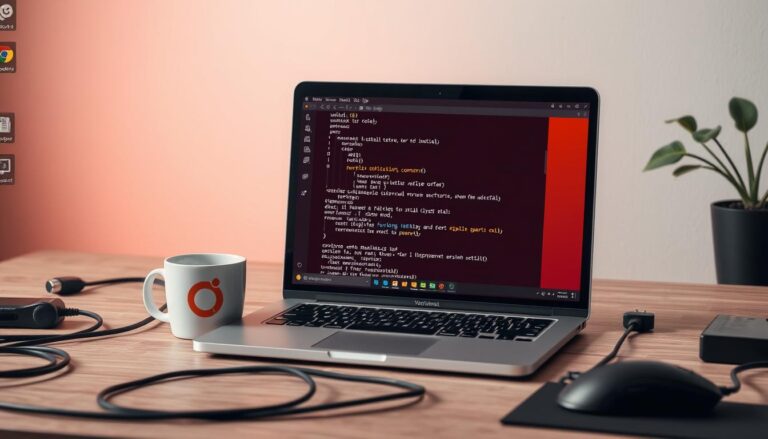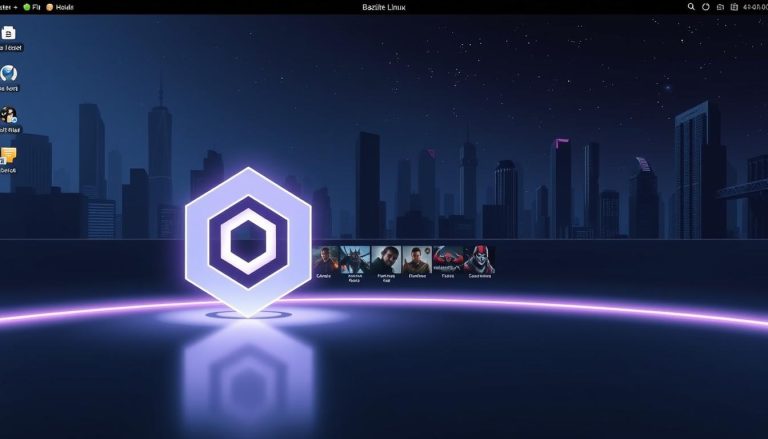Discover What is Parrot OS: A Comprehensive Overview
Have you ever wondered how cybersecurity professionals access such powerful tools for penetration testing and digital forensics? The answer lies in specialized operating systems designed specifically for security work. We introduce a revolutionary GNU/Linux distribution that has transformed the cybersecurity landscape since 2013. This platform provides security experts, developers, and privacy-conscious users with a comprehensive arsenal for IT security operations.
Created by Lorenzo Faletra, this Debian-based system originated as a community project and has grown into an internationally recognized platform. The project is now governed by Parrot Security CIC, a community interest company based in the United Kingdom.
This distribution offers more than just security tools—it embodies a philosophy of open-source collaboration and digital rights protection. Throughout this guide, we will explore its architecture, practical applications, and community ecosystem.
Whether you’re a seasoned cybersecurity expert or someone exploring privacy-aware computing, this comprehensive resource will help you understand how this powerful system can serve your specific needs.
Key Takeaways
- Parrot Security OS is a specialized Linux distribution built on Debian Stable
- Designed specifically for security professionals, developers, and privacy-focused users
- Includes a complete portable arsenal for IT security and digital forensics
- First released in 2013 by developer Lorenzo Faletra
- Governed by Parrot Security CIC, a UK-based community interest company
- More than just tools—embodies open-source collaboration and digital rights principles
- Suitable for penetration testing, security research, and privacy protection
Introduction to Parrot OS for Cybersecurity Enthusiasts
Digital security professionals witnessed a significant development in 2013 with the emergence of a Debian-based distribution designed specifically for their needs. This platform’s journey reflects the growing importance of specialized tools in modern cyber security operations.
History and Evolution of Parrot OS
Lorenzo Faletra launched the first public version on April 10, 2013, through the Frozenbox community forum. What began as a playful concept featuring a pirate theme quickly matured into a serious security distribution.
The project expanded from its Italian origins to become an international effort. Today, Parrot Security CIC governs the platform as a UK-registered community interest company.
Parrot OS in the Modern Cybersecurity Landscape
Current threat environments demand comprehensive solutions that support entire workflows. This system delivers complete environments for reconnaissance through reporting.
The development philosophy balances accessibility for newcomers with sophisticated features for experienced professionals. This unique approach positions the platform perfectly for today’s ethical hacking demands.
As cyber attacks continue making headlines, this security toolkit provides essential resources for defenders and researchers. The global community ensures continuous improvement and relevance in the rapidly evolving digital security space.
Comprehensive Analysis: what is parrot os
Built upon the robust foundation of Debian, this security-focused system delivers unparalleled stability for critical operations. We examine its architectural design and specialized applications that distinguish it from general-purpose distributions.
Core Concepts and System Architecture
The platform functions as a completely portable laboratory for cyber security operations. Its architecture exposes system internals rather than hiding them, providing full transparency.
Professionals can monitor all running processes and understand the underlying mechanics. This visibility is essential for security testing and system analysis.
A custom hardened Linux kernel serves as the first line of defense. This modification provides maximum resistance against attacks in hostile environments.
Digital Forensics and Security Applications
For digital forensics work, the system implements multiple protection layers. Automount functions remain disabled by default to prevent evidence contamination.
This redundant configuration spans from kernel boot options to file manager settings. Investigators must explicitly mount storage devices, eliminating accidental writes.
The environment supports comprehensive security operations beyond penetration testing. Defensive operations and incident response benefit from these forensic safeguards.
Editions and Versions of Parrot OS
Choosing the appropriate version depends on individual requirements and technical expertise. The platform offers three primary editions to accommodate different user scenarios.
Security Edition vs. Home Edition
The Security Edition provides a complete penetration testing workstation. This full-featured release includes hundreds of pre-installed security tools ready for immediate use.
In contrast, the Home Edition offers the same underlying system architecture without specialized security applications. This makes it ideal for daily computing with privacy focus.
Both editions share identical repositories and core components. Users can transform the Home Edition into the Security Edition by installing additional packages.
Architect and Cloud Variants
The Architect Edition represents the minimal installation choice. Weighing only 379MB, it contains no pre-installed software for complete customization.
This edition supports multiple architectures including amd64, i386, and arm64. The arm64 version works with Apple’s M1/M2 processor devices.
Cloud variants are specialized releases for embedded devices and virtual environments. They provide terminal-focused experiences optimized for specific deployments.
This flexible edition strategy ensures users select the right starting point based on available storage and intended use case.
Key Features and Security Tools of Parrot OS
Security professionals require comprehensive toolkits for effective operations. This distribution delivers an extensive collection of security tools designed for modern cybersecurity challenges. The platform’s architecture prioritizes both functionality and protection.
Built-in Penetration Testing and Hacking Tools
The Security Edition includes hundreds of pre-installed applications for penetration testing. These security tools cover every phase of security assessment, from reconnaissance to reporting. The collection matches or exceeds other specialized distributions.
Users benefit from efficient packaging that maintains a lightweight system footprint. The software selection includes network analyzers, vulnerability scanners, and forensic tools. This comprehensive approach supports complete security workflows.
Beyond specialized security tools, the platform includes development environments and privacy software. This eliminates the need for additional installations for most security tasks.
Enhanced Hardening and Sandbox Options
Custom hardening profiles provide multiple layers of protection against threats. These security features draw inspiration from privacy-focused projects like Tails and Whonix. The system implements AppArmor configurations and other Linux hardening technologies.
Critical applications run without unnecessary root permissions, limiting exploit damage. This protection extends to web browsers, media players, and document readers. The hardening techniques effectively mitigate risks from zero-day vulnerabilities.
Network services remain disabled by default, enhancing security in target environments. Users maintain full control over administrative functions when needed. For more details on these security features, explore the official documentation.
Parrot OS for Ethical Hacking and Penetration Testing
Modern cyber security engagements demand specialized platforms that can handle complex ethical hacking scenarios from start to finish. This distribution provides a complete environment supporting the entire security assessment workflow.
Practical Use Cases in Cybersecurity
Professionals conduct entire penetration testing operations using just a single ISO file and standard laptop hardware. This eliminates equipment switching during client engagements.
The platform supports diverse security testing methodologies including network assessments and web application vulnerability scanning. Social engineering campaigns evaluate human security factors effectively.
Reverse engineering operations for malware analysis and exploit development benefit from the comprehensive tool collection. The system handles assessments across various technology stacks.
Benefits for Security Professionals and Researchers
Unlike minimal testing distributions, this environment includes productivity software for report writing and team communication. It creates a complete working platform rather than just hacking tools.
Security experts gain a hardened platform while students access educational resources with necessary learning tools. Researchers benefit from cutting-edge security techniques available immediately.
The design philosophy of exposing system internals provides valuable educational insights. Users understand exactly how security operations function at the fundamental level.
All capabilities operate within strict ethical frameworks for authorized testing and research. Professionals can learn advanced techniques while maintaining responsible practices.
System Requirements and Performance Insights
Evaluating the technical demands of a security platform is a critical first step. We examine the hardware needed to run this robust cybersecurity toolkit effectively.

The minimum system requirements are remarkably modest. You need only 320MB of RAM, a 1GHz dual-core CPU, and 16GB of storage space. This accessibility allows the platform to operate on hardware that struggles with modern alternatives.
No dedicated graphics acceleration is necessary. The desktop environment prioritizes efficiency over visual effects, functioning perfectly on systems with integrated graphics.
Hardware and Resource Considerations
Support for both legacy BIOS and modern UEFI boot modes ensures compatibility across decades of computer hardware. This provides maximum flexibility for deployment in various scenarios.
While the minimum specifications allow the system to function, we recommend at least 4GB of RAM for the Security Edition. This ensures smooth multitasking when running multiple security tools simultaneously.
The 16GB storage requirement covers the base installation. Users conducting extensive penetration testing should plan for additional space for data and reports.
This exceptional lightweight nature and performance optimization make it an excellent choice for older hardware. It supports environmental sustainability by giving outdated machines new purpose.
Despite the minimal resource footprint, the platform delivers full functionality. It achieves efficiency through careful optimization, not feature removal. This distinguishes it from other lightweight distributions.
These performance characteristics are ideal for various deployments:
- Older laptops for field work
- Resource-constrained virtual machines
- Embedded devices for specialized applications
Installation Methods and User Experience
Users have multiple deployment options when setting up their security environment, each with distinct advantages. We guide you through selecting the optimal approach based on your hardware availability and intended use cases.
Live USB, Hard Disk, and Virtual Installations
The Live USB method offers maximum portability with minimal commitment. You can boot from any compatible computer using an 8GB USB drive without altering the host system.
For permanent setups, hard disk installation provides complete system control. This approach dedicates hardware exclusively to security operations with full persistence.
Virtualization delivers exceptional flexibility through platforms like VirtualBox or VMware. Users can allocate adjustable resources while maintaining safety within a contained environment.
Dual Booting with Windows and Ease of Use
Dual boot configuration allows seamless switching between operating systems. During startup, users select whether to access Windows for general tasks or the security platform for specialized work.
The installation process features intuitive graphical guides for partitioning and configuration. This accessibility ensures even newcomers can successfully deploy their security workstation.
Regardless of your chosen method, the comprehensive tool collection remains consistently available. The user experience balances professional familiarity with newcomer accessibility.
Community and Development in Parrot OS
Behind every successful security platform lies a vibrant community that drives innovation and support. What began as Lorenzo Faletra’s Frozenbox forum project has grown into a global network of developers, security experts, and privacy advocates.
Open Source Contributions and Developer Support
This distribution operates as a fully open source project with all code accessible on GitLab and GitHub. Anyone can inspect, modify, and contribute to components of the platform.
The development workflow ensures quality through local testing, team review, and beta campaigns. This process maintains the distribution’s reliability for security professionals.
Staying Updated with Releases and Innovations
Regular updates incorporate community feedback and modern security requirements. Version 6.0 “Lorikeet” represents the latest major release with enhanced features.
The community structure includes specialized channels for support, development discussions, and technical topics. These spaces facilitate knowledge sharing across different skill levels.
Engaging with the Global Cybersecurity Community
Community values emphasize kindness, respect, and guidance for newcomers. These principles create a welcoming environment for all participants regardless of background.
Engagement opportunities include tutorial series, monthly learning sessions, and collaborative challenges. Contributors at any technical level can strengthen the ecosystem through coding, documentation, or support.
This collaborative model ensures the platform remains responsive to real-world security needs. The global network continuously integrates the latest tools and techniques for effective cybersecurity operations.
Conclusion
Our comprehensive guide demonstrates how this security platform delivers professional-grade capabilities with remarkable accessibility. The distribution successfully bridges expert requirements with newcomer learning curves.
Parrot Security offers multiple editions catering to diverse cybersecurity needs. From full penetration testing workstations to privacy-focused daily drivers, there’s an appropriate choice for every scenario.
The lightweight performance ensures this environment runs efficiently on various hardware. This flexibility makes it accessible for both resource-constrained setups and modern deployments.
Beyond technical features, the vibrant community and open development model ensure continuous evolution. This collaborative approach keeps the platform relevant against emerging threats.
We encourage you to use Parrot through your preferred installation method. Whether testing with Live USB or deploying a dedicated workstation, this specialized operating system provides the complete environment for security success.
This Linux distribution represents more than just tools—it’s a comprehensive ecosystem supporting ethical research and digital rights protection.
FAQ
What editions of Parrot OS are available?
How does Parrot OS support ethical hacking?
What are the system requirements for running Parrot OS?
Can I run Parrot OS alongside Windows?
How often is Parrot OS updated?
What makes Parrot OS different from other security distributions?
Is Parrot OS suitable for beginners in cybersecurity?
What desktop environments does Parrot OS support?
How does Parrot OS ensure user privacy?
Can I contribute to Parrot OS development?
- About the Author
- Latest Posts
Claudia Rothenhorst ist Medien- und Reise-Redakteurin bei der Web-Redaktion. In ihrer Freizeit reist sie gerne und schreibt darüber unter anderem auf Reisemagazin.biz.
Weitere Artikel von Ihr erscheinen u.a. im Blog der Webagentur Awantego.






